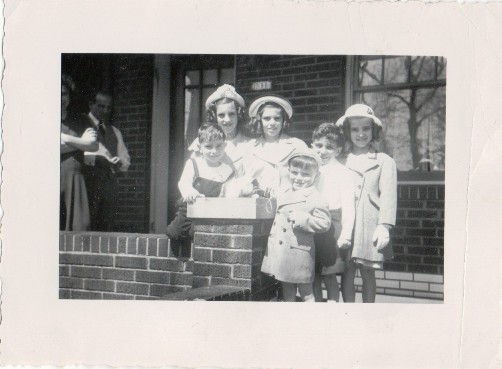

| Contact me | | | Ryan-Dennis | | | Dunn-Timothy | | | Ryan-Timothy | | | Ciaramitaro-MO | | | Ciaramitaro-MA | | | Ireland-Italy |

From left: Katie and Jim Sharamitaro watch as their children gather with cousins for Easter Sunday Mass at St. James the Greater Catholic Church in St. Louis, Missouri
Sicilian Traditions
Practically all Sicilian traditions revolve around or are in some way related to the church. Superstitions and celebrations are as much a part of the Sicily culture as are language, cuisine and art. Most Sicilians are devout Roman Catholics and very superstitious.
Most Sicilians view Friday the 13th as a very unlucky day. It is believed that Christ was crucified on a Friday. On Friday, October 13, 1307, the Pope, in conjunction with the King of France, issued a secret death warrant for the Knights Templar, who for 200 years had protected pilgrims making their way to the Holy Land.
Other Sicilian traditions are simply of a superstitious nature. If you enter someone’s home through one door, you should also leave through that same door. Otherwise, it’s bad luck. The origin of this tradition is unknown.
Sicilians say that if you want to sell your house you should bury a plastic statuette of St. Joseph, upside down in the front yard. Preferably under the “For Sale” sign
Going to the church and lighting a candle is a big part of Sicilian culture. Prayers are always said for the sick and the dying, as well as the dead. Even though Catholicism is the major religion today, there are still remnants of the old “pagan” religion. The Trinacria (a symbol that is seen on many buildings and now graces the official Sicilian banner) is a symbol that was originally put on Pagan temples, to scare off invading armies.
In Sicilian culture, children are very important and naming a child is an occasion for feasting. Traditionally, children are named after their grandparents, with names chosen first from the father’s side of the family and then from the mother’s.
Feasts are a big part of most Sicilian traditions and holidays, with good reason.
Sicilian food is plentiful and delicious. Pastries, seafood, tomatoes, artichokes, olives, apricots and all varieties of fruits and vegetables grew well on the island. There are many noted wines that originate from Sicily. Wine accompanies most meals and celebrations.
Carnivals are a famous part of Sicilian culture.
Floats are large and decorative. Booths line the city squares during carnival. Fireworks are popular and food is everywhere. Other than the religious festivals of Easter, Christmas and other holidays, carnivals are considered the most important events of the year.
The center of the family is 'la madre', the Mother.
She is held second only to the Virgin Mary who is believed to have been Sicilian; after all, the son she adored lived with her until he was 30, and when he was killed she maintained an air of dignified composure!
Today, it is difficult to describe Sicilian culture in brief, because there are huge differences between modern-minded city dwellers and traditionally conservative countryside people.
Back to topOn the St. Joseph’s Day Table
The Sicilian-American respect for San Giuseppe (St. Joseph) is reflected in the celebration of the Feast of St. Joseph, every March 19. Many families prepare a "St. Joseph's Day table", at which relatives or neighbors portray Jesus, Joseph and Mary and oversee the serving of meat-free Lenten meals to the poor of the community. The tables are the vestiges of a Sicilian legend which states that farmers prayed to St. Joseph, promising that if he interceded in a drought, they would share their bounty with the poor.
A Few family shared traditions
It was a custom way back in the late 1800’s and early 1900’s that if your child or baby dies, you try to have another and give the second child the same name as the first child that died.
“Her” mother told her that you had to get married by a justice of the peace first and not live together, and then get married again in church. My husband reminded me that was the way they did it in Europe. Married twice.
Various selections above are from “The Beauty and Romance of Sicily.com”
| HOME | DOGTOWN |
| Bibliography | Oral history | Recorded history | Photos |
| YOUR page | External links | Walking Tour |